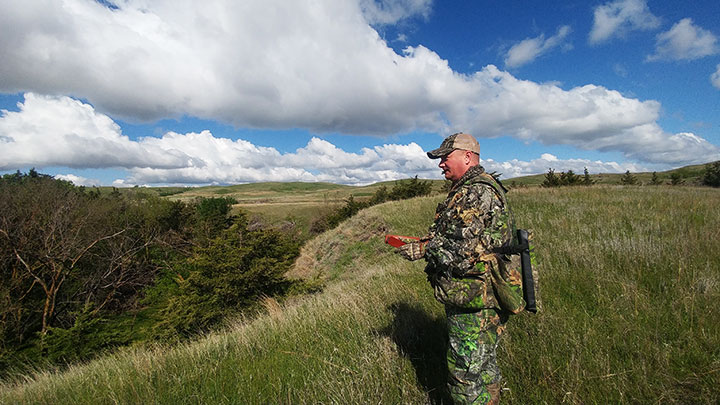There’s a reason why many hunters cite spring turkey hunting as their favorite pursuit of all. It’s because one encounter with a raucous, king-of-the-woods gobbler as it’s coming into your calls will make your knees knock and your heart lurch.

But turkeys have eyesight sharp as cut glass and are more wary than whitetails, so stalking one is difficult to impossible. Indeed, to have success this spring, you’ve got to know how to call one in. While master turkey callers spend a lifetime perfecting the craft and have dozens of various calling skills available in their repertoire, here are a few basic calls with which all turkey hunters should begin.
Calling turkeys consists of two main elements: Knowing how to make a specific call, and then knowing when to make it. For now, let's focus on three basic calls, each of which is demonstrated in the video embedded above.
Locator Calls
Locator calls aren’t calls that mimic turkeys; rather they are imitative sounds of other animals that challenge a gobbler’s dominance and spur them into gobbling—such as owls, crows, woodpeckers, hawks and others. When an owl hoots at dawn, for example, an old boss gobbler can’t stand it, so he’ll often gobble back at the owl to let him know who’s boss. (Or at least this is what we think is going on in a turkey’s brain.) This stimulus/response mechanism in springtime gobblers is nearly automatic, meaning that no matter how many times an owl hoots (or a crow crows, or a woodpecker cries) the gobbler nearly always answers back. And when he answers, he gives away his position so an astute hunter can move in on him and formulate a plan of attack.

So, all turkey hunters should know how to make an owl call. I can make the sound by blowing air through my hands or just with my voice, but I prefer a store-bought owl call because I can use it while wearing gloves--and it’s much louder than my voice alone. I like the Big Hooter Owl Call made by Hunter’s Specialties/HS Strut, because it’s loud and easy to blow. (HS also makes an instructional DVD on turkey calling, and I highly recommend it).
The Call: Owl Hoot
Using a tremendous amount of air pressure by filling up your lungs, blow into the call with short, powerful bursts of air. After you purchase a call, click here to learn how owl calls sound, or better yet, spend time in the woods at dawn and dusk, and listen to the call of a barred owl. Then try to mimic the owl’s nine-syllable call that sounds like “Who-cooks—for-you; Who-cooks—for—you-all?
When to Call
Gobblers respond best to owl calls in the morning just before dawn, while they’re still roosted in trees. So if you’re not sure if a gobbler is nearby, sneak to the edge of the woods or other vantage and rip off a loud hoot. If there’s a gobbler within a couple hundred yards, he should answer. If he does, make note of exactly where the sound came from; you have just located a gobbler! If one doesn’t gobble, move a couple hundred yards to another location and try it again. You can use an owl hooter—often with success—anytime of the day to locate gobblers. So keep it handy and use it often.
Hen Calls
Female adult turkeys, or hens, make many types of calls including clucks, purrs, putts, cutts and others. But the staple call they use to attract a potential mate is called the yelp.
The Call: Yelp
A yelp is a series of short, high-pitched sounds that a hen uses to call to its clutch, other hens and to gobblers in an effort to find a mate. The sound can be made with a box call, a slate call, a mouth call (also called a diaphragm call) and others. But for beginners, I recommend the slate call (also called a pot call), like this one made by Zink Calls. Less expensive slate calls are readily available from Primos, Hunters Specialties, Knight & Hale and other callmakers.
The call consists of about 9 to 12 two-note yelps that, when made in a rhythmic series, sound somewhat like “yyyyeeee-elp, yyyeeee-eelp, yyeeee-eelp, yeeeelp, yeeeelp, yeelp, yelp, yelp, yelp, yelp.” Start by placing pressure on the striker upon an edge of the slate call, then drawing the stiker swiftly about an inch to the middle, then making a circle with the striker so the sound can be quickly and rhythmically repeated.

Because it’s virtually impossible to teach a new caller how to make sounds via written words, again, it’s best to watch one of the many online instructional videos on call makers' websites or on YouTubeto actually hear the tone and cadence of a yelp. Or, you can sit in the woods and listen to actual hens and try to mimic them. However, the cadence and knowing when to call is more important than the exact tone, because all hens sound a little different; some are raspy and may have a shorter series of yelps while others are more high pitched.
When to Yelp
In the springtime woods when the sun is up and birds have flown to the ground from their roosts, there is really no bad time to yelp. A yelp tells other turkeys, “hey, I’m over here”; and/or “why don’t you guys come over here?” It also says to a prospective gobbler, “Hey big boy, you sound cute. Are you looking for a date? Come on over here.”
So, a yelp can be used to entice a gobbler to gobble. Then, when a gobbler responds, a series of yelps is best used to attract the gobbler within shotgun range.
If a gobbler begins coming to you after you yelp, you should use the yelp call sparingly. Afterall, if a gobbler is coming to you, he’s doing what you want him to; calling more might make him change what he’s doing. Again, yelp sparingly, because sometimes an old gobbler can be attracted to a hen that plays a little hard to get.
Remember, if you’re calling to a gobbler and it chooses to be silent as it comes in, you may not know it’s coming. But rest-assured it is looking for the maker of the calls (you!), so it’s critical that you remain as still as possible. One movement—even a slight move of the head or a hand that swats a mosquito—will likely cause the gobbler to flee. And for this reason, when using a pot call, it's best to keep the movement of your hand as it moves the striker concealed behind your knees or other objects such as foliage.
The Call: Cluck
When hens aren’t alone, lost or asking their family or a gobbler to “come over here,” they constantly make little clucks and purring sounds as they feed and when they’re content. If you’ve ever heard a flock of chickens feeding in a barnyard, you’ll notice that all of them make many clucks, purrs and putt sounds most all of the time. So do turkeys. Clucks convey to other turkeys that “all is good,” and “this grub is good, sister. All is well.”
While clucks sound subtle to us, gobblers hear them well and make them comfortable. If a gobbler thinks hens are around, it would sound weird to him—even alarming—if no natural clucks are coming from the hens. So hunters should learn a basic cluck that can be used to calm and attract gobblers.

To make a cluck, simply place pressure on the striker toward the middle of the pot call, then draw it firmly and swiftly about a half inch across the slate so it makes a very soft sounding “cluck” noise. Again, the best way to learn the cluck is to listen to audio of a cluck. A cluck is not so much to call in another bird, but rather a noise made by a turkey out of contentment, almost as a cat purrs. But because turkeys are gregarious animals, other turkeys can hear that content and be attracted to it. So you should know it.
When to Cluck
Anytime you’re set up in the woods and ready to see or hear a turkey is a good time to cluck. Mainly, however, clucks should be used randomly between series of yelps to let nearby turkeys know the following: 1. A hen or a group of hens are nearby; 2. They’re very comfortable, relaxed and probably feeding; and 3. they can come on over if they want.
Often some simple clucking—rather than loud raucous yelping—can soothe shy gobblers and convince them to come in even if perhaps they don’t feel like actually breeding at the moment. Unlike yelping, it’s difficult to cluck too much, provided you keep your clucking very soft and subtle.

Like any instrument that produces sound, turkey calling requires practice to make the sounds perfectly, every time, and while your adrenaline surges. Then you should know when to use them, and when to use restraint not to overcall. With time and experience, you can become a master that few gobblers can resist. But expect to send a few running the opposite direction in the process.






















